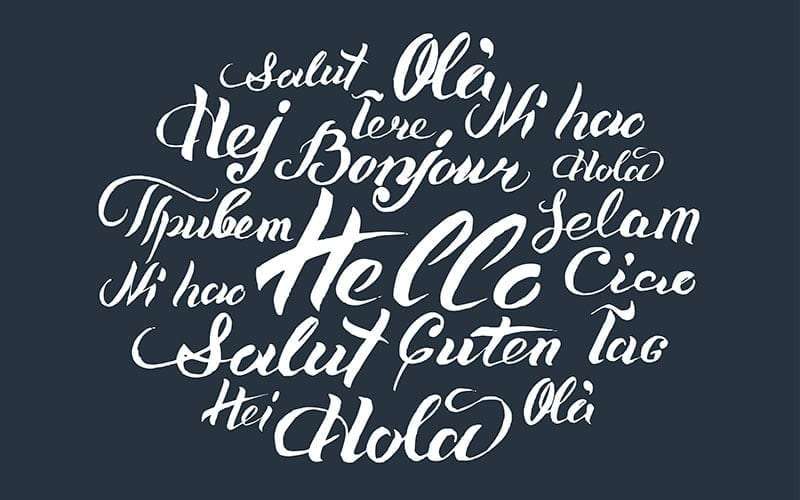
What Is The Definition Of Translation?
Translation deciphers the meaning of the written word from one language to another. Translators must capture the content, style, and form of the original text accurately and precisely and then render it into the target language.
What Does Translation Involve?
- The translator must read the text in the source language, decipher its meaning, then write, rewrite and proofread the content in the target language to ensure the original meaning, style and form are maintained. Depending on the context, the translator may need to apply thorough research and consultation techniques to the work at hand in order to widen his or her understanding of the subject. The final product should be polished, eloquently written and completely free of error.
- Translators can take transcribed information and turn it into pristine prose in the language that you need. Translators may utilize technologies and reference materials to generate accurate, high-quality translations.
- Quality translation involves knowing the context and cultural background from which the words in the original text came, and then choosing words and phrases in the new language which will best convey the substance and meaning of the original in a new and different cultural context. Unless all this happens, the message may get misinterpreted or even lost.
- Translation is an interpretative act, as well as a creative one. Translators read the original piece and try to work out what it’s doing, what’s important that’s going on. They are constantly making choices about which elements of a text to preserve and foreground, and which to sacrifice.
What Are The Different Types Of Translation?
- Human Translation. Relying on pure human intelligence to convert one way of saying things to another. And while human translation comes in many different flavors, it remains the most widely-used translation method to this day. Human translation is your best bet when accuracy is even remotely important. When working with human translation providers, you can expect to get a much better quality output compared to machine translation or human aided machine translation. (For more on human translation check out An In-Depth Look Into Human Translation.
- Machine Translation. Machine translation (MT) is the automated translation of source material into another language. MT has greatly improved in speed and accuracy in recent years due to advances in software and hardware alike. Machine translation engines can process millions of words per hour and produce reasonably accurate, usable translations in nearly any language.
- Machine Translation Plus Post-Editing. Machine translation tends to be literal, missing the subtleties of intent. That is why human translation is still required when machine translation occurs. Machine translation plus post-editing is a hybrid of MT and traditional, human translation. As its name suggests, post-editing follows the MT process. First, a software produces an initial translation of the material, making short work of bulk translation tasks. Once this initial translation is complete, human translators take the text and edit it for accuracy, clarity, flow, and local resonance. In short, they check the machine’s work and infuse the copy with the qualities only a human can provide.
- This human touch brings a level of nuance that machines can’t match. This is especially important when content is highly technical, deals with sensitive cultural issues features jokes or wordplay, or captures an important particular tone. For clients, the benefits are twofold. This method couples the unparalleled speed of MT with the attention and sensitivity of a human translator.
- Most translators can work more quickly as editors than as from-scratch translators. Because the initial MT translation saves translators hours of work, MT with post-editing is one of the quickest (and most affordable) ways to get high-quality results.
Which Translation Method is Best?
- Machine translation enables lightning-speed translations, but they may lack the nuanced quality and professional assurance of a human translation. What should you do if you need more than machine translation—fast?
- Machine translation with post-editing by a human translator, while not quite as fast as raw machine translation, can give your copy a more polished and professional feel.
What Are The Features of Translation?
- Unlike transcription, transcription only deals with one language. Translation requires handling two languages – the source language and the target language.
- Often, the translator deals with written content, although there are times when clients only have audio or video recording of the source materials. In this case, the media file has to be transcribed first before it can be translated.
- The translator has to be highly skilled in creative writing to accurately deliver the intended message of the source document.
- Due to globalization and multiculturalism, translation is very essential in facilitating mutual understanding and better communication among people speaking different languages. The availability of translated content increases its accessibility, thereby increasing the content’s reach, potentially. From a legal point of view, delivering content in different languages shows acceptance of diversity.
- Translation deals with one type of format – written content (transcription deals with audio).
- Translation handles two main categories, literary and non-literary. As the name implies, literary translation involves the translation of literature such as poems, stories, and novels. Non-literary translation translates legal, scientific, technical and other specific documents.
- The translator must be very proficient in the target language, so it is vital to work only with translators who are native speakers. The translator also has to have a deep understanding of the culture of the target language as well as its nuances, grammatical differences, idioms, slang, and idiomatic expressions.
What Is The Importance Of Translation?
Translation services facilitate global communication, global reach and enhance diversity. As it bridges the gaps of languages and people, it is a crucial process to enrich globalization.
- Growth of Multinational Companies. Translation is exceptionally important for companies and businesses which operate in multiple countries and often need to share and receive information from different global offices and branches across the world. In such cases, the shared information needs to be translated into a locally preferred language so that everyone involved is on the same page. Translation is also useful when companies need to tie up with local businesses or make governmental proposals.
- Cultural Interchange. Music, literature, films, and various other art forms transcend global boundaries because of the way they are effectively translated to reflect local languages and sentiments. Translated and subtitled films today generate more revenue than ever for the global film industry. And it’s not only the film industry which has benefited from translation, as translated music and literature allow artists to earn more royalties and international fame as an added bonus.
- Accurate Transfer of News. Unless transferred and translated properly, world news would be nothing more than gibberish when received by news agencies. Whether it is news coming from local bodies, regional centers, or even countries with strict news censorship, translation serves as an effective tool without which news will remain ineffective and unreliable.
Complete article on [Why Multilingual Translation Is Vital For Your Business…]
What Are Some Challenges Faced During The Translation Process?
- Slang. The use of slang is possibly the most difficult aspect of translating films. In the best of circumstances, cultural insinuations can be tough to describe – even in the same language – but these difficulties increase exponentially when translating into a different language. For your amusement, let’s consider this Dutch saying: ‘Da’s kloten van de bok.’ It’s typically translated to be ‘that’s very bad’ or ‘that’s rotten’, but the literal translation is actually ‘that’s testicles of the goat’, which, when taken out of context, makes absolutely no sense at all in English! So, it’s because of these cultural differences that translators often take liberties when interpreting the meanings of certain phrases and words. Obviously, a translator’s ultimate goal is to convey the same idea, so, depending on the context in question, a number of phrases could be used to convey the same meaning.
- Nicknames. Film translators often find nicknames to be a tough aspect of translation because of the behavioral and cultural connotations involved. When we have a character known as ‘sticky fingers’ we would automatically assume it means that person is a kleptomaniac, while the Dutch version of ‘plakkerige vingers’ could fall very flat indeed. Some translators in cases like this simply use the original in the translated version, and while this is an easy solution, it’s not necessarily more effective than a literal translation. Film translators’ real challenge arises when it comes to nicknames in movies about organized crime or gangs, where almost every movie character has a name that’s been carefully crafted to describe their passion, predilection, or propensity. Perhaps the safest approach here is to take the use-it-as-it-is approach, which means that the translator maintains the integrity of the character’s name. Much less stress for the translator!
- Profanity. The use of profanity is another interesting area worth taking a look at. It’s often jokingly said that the first expressions and words one picks up from locals in a foreign country will always be connected in one way or another with swearing. However, it does very clearly show that swearing and profanity exist worldwide and that they’re unique to different cultures and different languages.
- Gestures. Gestures in film translation are extremely challenging. Perhaps the reason for this is that gestures mean entirely different things in different countries, which means that the translator must be aware of this.
Complete article on [Challenges Faced By Language Translators…]
What is the difference between Translation and Transcription?
- The difference between translation and transcription comes down to two words—words versus meanings. So if a person has an audio recording that needs to be converted into written text, it is transcription. If he needs the meaning of words in one language converted into another language while keeping the meaning intact, it is translation. Despite these differences between translation and transcription, it is important to know that they both are essential parts of a translation agency’s business and are likewise required for lowering the linguistic barriers set by geographical boundaries in the world.
- In Translation, the source of this process has to be in written format only. In transcription, the source of this process can be an audio file, sign language or even a video recording.
Complete article on [Distinction Between Translation And Transcription…]
Conclusion
Translation requires intimate knowledge of both the source language and the target language to be effective. Otherwise, the translation risks being literal – or worse. A good translator knows how to turn one language into a usable version of another: a great translator makes an effortless piece of writing that the target reader would never guess was translated from another language. Translation is a necessity for the worldwide distribution and exhibition of films. No-one would ever say that film translation is an easy task – not even an experienced, professional film translator.








Comments (3)
Agen Poker Online
November 10, 2020Hmm it looks like your website ate my first comment (it was extremely long) so I guess I’ll just sum it up what
I submitted and say, I’m thoroughly enjoying your blog.
I as well am an aspiring blog writer but I’m still new to everything.
Do you have any helpful hints for inexperienced blog writers?
I’d definitely appreciate it.
idn poker
January 4, 2021This is a very good tip particularly to those new to the blogosphere.
Brief but very precise information… Many thanks for sharing this
one. A must read article!
Bess Rodemeyer
January 19, 2021I’ve read some good stuff here. Definitely worth bookmarking for revisiting. I surprise how much effort you put to make such a magnificent informative site.
Comments are closed.